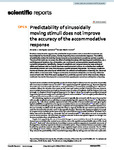Predictability of sinusoidally moving stimuli does not improve the accuracy of the accommodative response
| dc.contributor.author | Águila-Carrasco, AJD | |
| dc.contributor.author | Marín-Franch, I | |
| dc.date.accessioned | 2021-08-09T11:16:31Z | |
| dc.date.available | 2021-08-09T11:16:31Z | |
| dc.date.issued | 2021-07-26 | |
| dc.identifier.issn | 2045-2322 | |
| dc.identifier.issn | 2045-2322 | |
| dc.identifier.other | 15195 | |
| dc.identifier.uri | http://hdl.handle.net/10026.1/17459 | |
| dc.description.abstract |
<jats:title>Abstract</jats:title><jats:p>Previous research work suggests that predictable target motion such as sinusoidal movement can be anticipated by the visual system, thereby improving the accommodative response. The validity of predictable motion for studying human dynamic accommodation is sometimes put into question. The aim of this work was to assess the effect of anticipation along with learning (and motivation, etc.) and fatigue (and boredom, loss of attention, etc.) on dynamic accommodation experiments from a practical perspective. Specifically, changes in amplitude and temporal phase lag were estimated within and between trials as 9 adult observers were instructed to focus on a stimulus that oscillated sinusoidally towards and away from the eye at specific temporal frequencies. On average, amplitude decreased whereas phase increased within trials. No evidence of anticipation or learning was observed either within or between trials. Fatigue consistently dominated anticipation and learning within the course of each trial. Even if the eye is equipped by a <jats:italic>prediction operator</jats:italic> as it is often assumed, fatigue confounds the results from dynamic accommodation experiments more than anticipation or learning.</jats:p> | |
| dc.format.extent | 15195- | |
| dc.format.medium | Electronic | |
| dc.language | en | |
| dc.language.iso | en | |
| dc.publisher | Nature Research (part of Springer Nature) | |
| dc.subject | Clinical Trials and Supportive Activities | |
| dc.subject | Basic Behavioral and Social Science | |
| dc.subject | Behavioral and Social Science | |
| dc.subject | Clinical Research | |
| dc.subject | Eye Disease and Disorders of Vision | |
| dc.title | Predictability of sinusoidally moving stimuli does not improve the accuracy of the accommodative response | |
| dc.type | journal-article | |
| dc.type | Journal Article | |
| plymouth.author-url | https://www.webofscience.com/api/gateway?GWVersion=2&SrcApp=PARTNER_APP&SrcAuth=LinksAMR&KeyUT=WOS:000680872700029&DestLinkType=FullRecord&DestApp=ALL_WOS&UsrCustomerID=11bb513d99f797142bcfeffcc58ea008 | |
| plymouth.issue | 1 | |
| plymouth.volume | 11 | |
| plymouth.publication-status | Published online | |
| plymouth.journal | Scientific Reports | |
| dc.identifier.doi | 10.1038/s41598-021-94642-2 | |
| plymouth.organisational-group | /Plymouth | |
| plymouth.organisational-group | /Plymouth/Faculty of Health | |
| plymouth.organisational-group | /Plymouth/Faculty of Health/School of Health Professions | |
| plymouth.organisational-group | /Plymouth/REF 2021 Researchers by UoA | |
| plymouth.organisational-group | /Plymouth/REF 2021 Researchers by UoA/UoA03 Allied Health Professions, Dentistry, Nursing and Pharmacy | |
| plymouth.organisational-group | /Plymouth/Users by role | |
| plymouth.organisational-group | /Plymouth/Users by role/Academics | |
| dc.publisher.place | England | |
| dcterms.dateAccepted | 2021-07-13 | |
| dc.rights.embargodate | 2021-8-25 | |
| dc.identifier.eissn | 2045-2322 | |
| dc.rights.embargoperiod | Not known | |
| rioxxterms.versionofrecord | 10.1038/s41598-021-94642-2 | |
| rioxxterms.licenseref.uri | http://www.rioxx.net/licenses/all-rights-reserved | |
| rioxxterms.licenseref.startdate | 2021-07-26 | |
| rioxxterms.type | Journal Article/Review |


